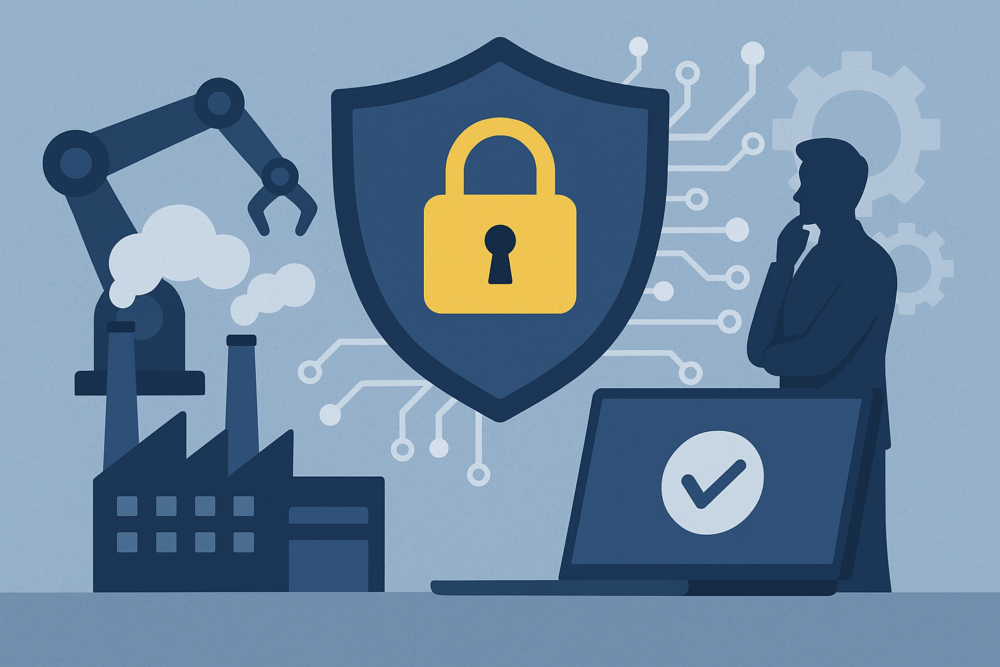Cybersecurity Management Plan for Manufacturing Explained
Cyberattacks on the manufacturing sector are no longer theoretical—they’re constant, targeted, and costly. From ransomware shutting down production lines to supply chain breaches exposing sensitive customer data, manufacturers now operate in one of the most threatened industries in the world.
The stakes are high: downtime means missed deadlines, contract penalties, and damaged reputations. And in today’s digital supply chain, a single cyber incident doesn’t just hurt one facility—it can cascade through vendors, partners, and customers in hours.
That’s why having a cybersecurity management plan for manufacturing is no longer optional. It’s the foundation for protecting operations, securing intellectual property, and complying with growing regulatory demands like CMMC, NIST 800-171, and ITAR.
A cybersecurity management plan goes beyond installing antivirus or setting up a firewall. It’s a documented, strategic framework that helps manufacturers identify risks, control access, respond to incidents, and recover without chaos. It defines who’s responsible, how threats are detected, and what happens when systems go down.
In this article, we’ll explain exactly what goes into a cybersecurity management plan for manufacturing, why it’s essential to both security and compliance, and how to build one that aligns with your facility, people, and operational technology.
What Is a Cybersecurity Management Plan?
A cybersecurity management plan is a documented strategy that outlines how your business identifies, mitigates, monitors, and responds to cybersecurity threats. For manufacturers, it acts as a blueprint for protecting production systems, intellectual property, sensitive data, and the continuity of operations.
Unlike one-off policies or IT toolkits, a cybersecurity management plan connects people, processes, and technology into a unified, evolving strategy. It establishes roles and responsibilities, defines acceptable use, enforces controls, and ensures the organization is prepared to handle incidents—from malware infections to compliance audits.
It includes:
– Policies and controls
– Operational procedures
– Roles and responsibilities
– Security training requirements
– Incident response playbooks
– Backup and recovery plans
– Compliance documentation and audit prep
In short, it’s the operational framework that turns good intentions into measurable security outcomes.
Why Manufacturers Are High-Value Targets
Manufacturing networks include legacy machines and control systems never designed with security in mind. These assets may run outdated operating systems, lack patching capabilities, or be directly connected to corporate networks or the internet.
Cybercriminals target manufacturers knowing every minute of downtime costs money. They exploit urgency with ransomware attacks, knowing it can bring operations to a halt.
More manufacturers are also being asked to prove security maturity. Without a cybersecurity management plan, they risk non-compliance, contract loss, audit failures, and legal exposure—even if no breach has occurred.
7 Key Elements of a Cybersecurity Management Plan
- Risk Assessment and Asset Inventory
This step lays the foundation for every security decision you’ll make. It involves identifying all critical IT and OT assets across your environment—including servers, control systems, user devices, network infrastructure, and vendor access points. Once assets are identified, conduct a risk assessment to understand vulnerabilities, likelihood of exploitation, and potential business impact. Prioritize remediation and controls based on operational risk, not just technical risk.
- Security Policies and Access Controls
Security begins with clear expectations. Your plan should define and enforce policies around user behavior, device usage, password standards, mobile access, and acceptable software. Layered access controls must limit system permissions to only what each user needs—especially in OT environments where an operator should not have access to engineering systems. Policies should also govern third-party vendor access and how that access is granted, monitored, and revoked.
- Monitoring and Threat Detection
Proactive monitoring allows you to catch malicious behavior before it becomes a full-blown incident. Implement centralized logging and real-time alerting using SIEM (Security Information and Event Management) systems. Use endpoint detection and response (EDR) tools on critical systems, and monitor OT network traffic for anomalies or protocol misuse. Your plan should specify which systems are monitored, how alerts are handled, and who is responsible for reviewing them.
- Incident Response and Business Continuity
A well-written response plan turns chaos into coordinated action. It should outline who is responsible for each response role (e.g., containment, communication, remediation), include escalation paths, and provide detailed steps for common scenarios like ransomware, insider threats, or data theft. Integrate your incident response strategy with broader business continuity plans, ensuring that critical operations can resume quickly—even during an investigation or system recovery.
- Data Protection and Backup
Your data protection strategy should include multiple layers: encryption for data in transit and at rest, strict access control for sensitive files, regular data integrity checks, and offline or immutable backups that cannot be deleted by ransomware. Define recovery point objectives (RPOs) and recovery time objectives (RTOs) that reflect business needs—not just IT capacity. And most importantly, test your backup restoration processes regularly.
- Compliance Documentation
Without documentation, you can’t prove compliance. Your plan should specify how policies are approved, stored, and updated. Track who has access to sensitive systems and data, log administrative actions, and map your controls to frameworks like CMMC or NIST 800-171. Include logs, assessments, vendor due diligence records, and user training attestations as part of your compliance library. Auditors won’t take your word—they’ll want proof.
- Training and Human Risk Management
The human element is still the leading cause of cyber incidents. Your plan should define a formal security awareness program for all staff, with role-specific training for engineers, IT, executives, and machine operators. Include periodic phishing tests, password hygiene campaigns, and simulations of common attacks. Make reporting suspicious behavior easy and reward proactive employee engagement. Culture is a key part of cybersecurity—and it starts with education.
What Happens Without a Management Plan
Disjointed security tools leave dangerous gaps. When there’s no central plan, teams scramble during incidents, tools operate in silos, and leadership lacks insight.
The result? Delayed response, compliance risk, failed audits, and prolonged downtime.
Cybersecurity without structure isn’t resilience—it’s reactive chaos.
How to Get Started with a Plan That Works
Start with a cybersecurity assessment. Involve IT and OT teams. Align the plan to your compliance requirements and risk level. Make it a living document—not a one-time checklist.
The right plan will evolve with your business and form the backbone of every security and compliance decision.
Download the Manufacturing Cybersecurity Assessment Guide
📥 Cybersecurity Assessment Guide for Manufacturing:
https://hs.rhtg.net/cybersecurity-assessment-guide-for-manufacturing
This guide includes templates, checklists, and evaluation steps to help you assess and prioritize risks across your manufacturing environment.
Build a Custom Cybersecurity Plan with RHTG
Every manufacturer has different risks and requirements. RHTG works with manufacturers to design custom cybersecurity plans aligned with your business, your goals, and your compliance needs.
📞 Request a Cybersecurity Proposal:
https://www.righthandtechnologygroup.com/request-a-proposal
Frequently Asked Questions
Q: What is a cybersecurity management plan for manufacturing?
A: It’s a documented framework for managing security risks, protecting systems, responding to incidents, and ensuring compliance in manufacturing environments.
Q: How is it different from a security policy?
A: A security policy is just one part of a broader management plan. A full plan includes roles, tools, training, response protocols, and compliance documentation.
Q: Why do manufacturers need a plan?
A: Because manufacturing is one of the most targeted industries for ransomware and supply chain attacks, and compliance frameworks demand written evidence of controls.
Q: What regulations require cybersecurity planning?
A: CMMC, NIST SP 800-171, ITAR, and ISO/IEC 27001 all require documented policies, recovery plans, and security governance.
Q: How long does it take to build one?
A: Most SMB manufacturers can build a solid plan within 30–60 days, especially with expert support. Complexity and current maturity level affect timeline.











